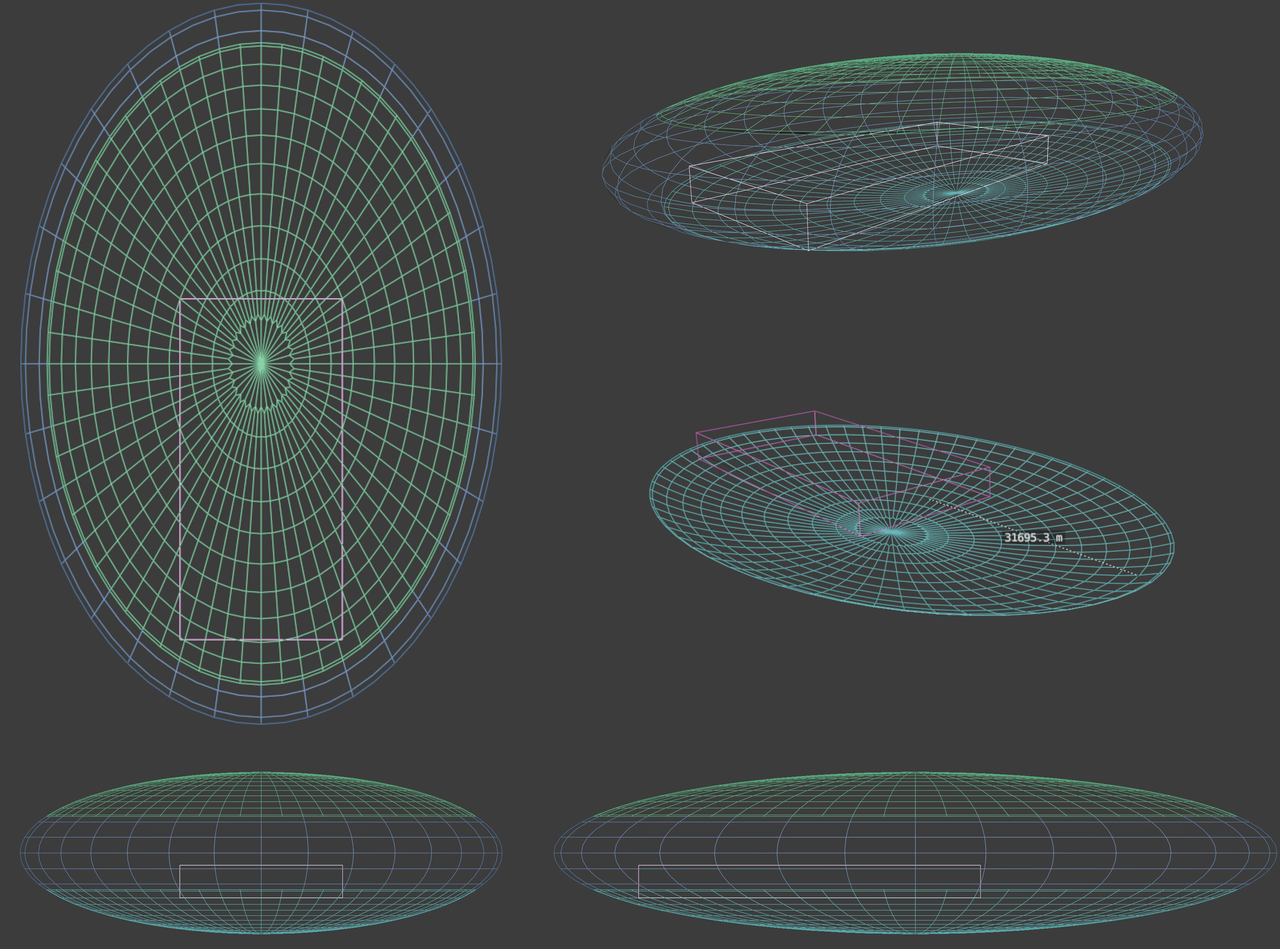HOME | DD
 endolith — Sleeper Service multiview projection
endolith — Sleeper Service multiview projection

#excession #blender #blender3d #render #sciencefiction #starship #wireframe #theculture
Published: 2020-11-29 04:44:49 +0000 UTC; Views: 332; Favourites: 2; Downloads: 0
Redirect to original
Description
My Blender shading skills are atrocious, but I can at least show my wireframe model and its justification (that I spent way too much time on).
Blue is the field enclosure, "a silvery ellipsoid ninety kilometres long, sixty across the beam and twenty in height." There are actually multiple concentric fields, but I'm not sure how far apart they are, and the dimensions given are a tight fit, so this is just the outer field dimensions, assuming the layers have relatively little distance between them.
White/pink is the ship itself, a "slab of power and substance floating in a giant spoonful of sea", which Specific_Ambiguity calculated from the descriptions of the internal bays to be 42×20×4 km, which would have a surface area of 840 km², which is consistent with "the great ship's flat top surfaces … measured over eight hundred square kilometres."
[2024 update: The Drawings shows it as having tiers, with overall dimensions 53×22×4 km . So much of this needs to be adjusted. The water displacement is higher because it's longer and wider, but less because the bottom is not quite rectangular, and that also allows it to be slid backwards a bit more.]
The ship is explicitly "four kilometres thick" and the rear wall of the ship is described as a "sheer, three-kilometre cliff" that goes directly into the sea(?), implying that 1 km of the ship is below sea level, displacing 42×20×1 = 840 km³ of water. Likewise, the front wall is described as "the foliage-strewn lip of the two-thousand-metre-high cliff", so the outer walls are essentially vertical, and the park extends right out to the edge and spills over it, or is at least visible above the edge from the beach below.
The rest is more speculative:
Cyan is the ocean, "About four thousand cubic kilometres of water". If there were no land/rock, and 840 km³ displaced by the ship, and filling the bottom of the field, this would reach a depth of 3.6 km in the center . This is the average depth of Earth's oceans, but I think it needs to be deeper; see below. (There's also some leeway here, since the mass is given in the book as "four gigatonnes", which is not consistent with the volume. The intended number was likely "four thousand gigatonnes".)
I haven't shown the land or tower because I'm not sure how much land there is. The ship lifts "several billion tonnes of real-enough rock" but that's only a few km³ , vs the 4000 km³ of water. Is that just the scree itself? Not the rest of the land?
The front wall of the ship is a "two-kilometre cliff … skirted by a rough slope of scree", implying 1 km of land built up above sea level? The scree is "easily twenty kilometres across" which matches the width of the ship above. The tower and beach are 1 km away from the cliff, on the land.
The ship must be offset towards the back, in order for the "top of the scree slope" to be 30 km from "the Edge islands … close to where the inner containment field of the ship came down like a wall across the sea" (distance shown). This is consistent with the rear of the ship touching "the shallow part of the sea". It's also described as "a hollow husk … with the ship as its vast, flattened kernel" which makes me think of the germ of a seed being at one end?
The ocean depth of 3.6 km isn't enough for the ship to be offset this far back without protruding through the field, so there must be substantial land and maybe underwater rock displacing the sea to raise it up? The Edge Islands have to be made of something, after all. So I increased the depth of the ocean until I could get the ship back far enough to get the required distance to the Edge Islands, so now the sea is about 4-5 km deep, an abyssal zone of permanent darkness . Seems plausible. (Mariana Trench is 11 km deep.)
Green is the gas giant atmosphere, which "in shape and density mirrored the grey, wind-ruffled sea." So I just made it equal and opposite across the top. This leaves 8 km from the beach up to the gas giant atmosphere, which is the height of cirrus clouds in our atmosphere, which seems plausible. The park land on top of the ship would be at an elevation similar to Mexico City, so not too bad.


















